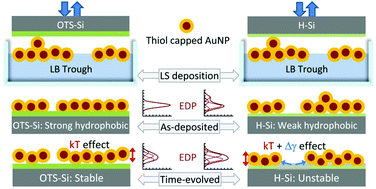Interfacial and thermal energy driven growth and evolution of Langmuir–Schaefer monolayers of Au-nanoparticles†
Abstract
Structures of Langmuir–Schaefer (LS) monolayers of thiol-coated Au-nanoparticles (DT-AuNPs) deposited on H-terminated and OTS self-assembled Si substrates (of different hydrophobic strength and stability) and their evolution with time under ambient conditions, which plays an important role for their practical use as 2D-nanostructures over large areas, were investigated using the X-ray reflectivity technique. The strong effect of substrate surface energy (γ) on the initial structures and the competitive role of room temperature thermal energy (kT) and the change in interfacial energy (Δγ) at ambient conditions on the evolution and final structures of the DT-AuNP LS monolayers are evident. The strong-hydrophobic OTS-Si substrate, during transfer, seems to induce strong attraction towards hydrophobic DT-AuNPs on hydrophilic (repulsive) water to form vertically compact partially covered (with voids) monolayer structures (of perfect monolayer thickness) at low pressure and nearly covered buckled monolayer structures (of enhanced monolayer thickness) at high pressure. After transfer, the small kT-energy (in absence of repulsive water) probably fluctuates the DT-AuNPs to form vertically expanded monolayer structures, through systematic exponential growth with time. The effect is prominent for the film deposited at low pressure, where the initial film-coverage and film-thickness are low. On the other hand, the weak-hydrophobic H-Si substrate, during transfer, appears to induce optimum attraction towards DT-AuNPs to better mimic the Langmuir monolayer structures on it. After transfer, the change in the substrate surface nature, from weak-hydrophobic to weak-hydrophilic with time (i.e. Δγ-energy, apart from the kT-energy), enhances the size of the voids and weakens the monolayer/bilayer structure to form a similar expanded monolayer structure, the thickness of which is probably optimized by the available thermal energy.



 Please wait while we load your content...
Please wait while we load your content...